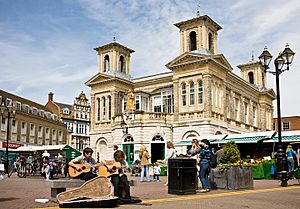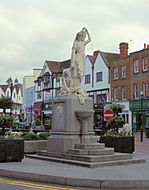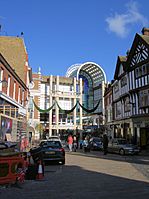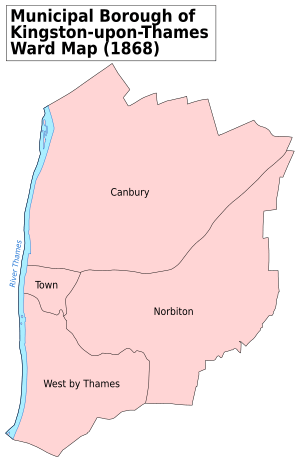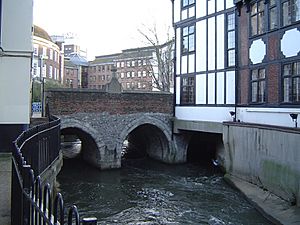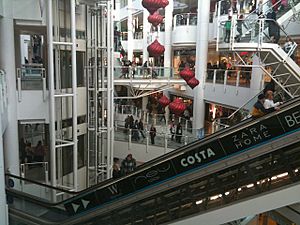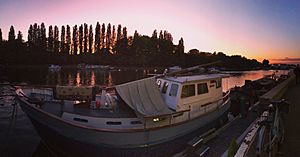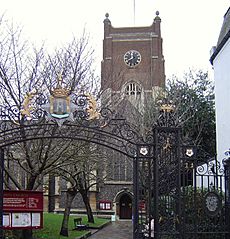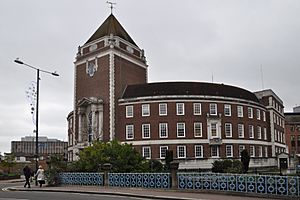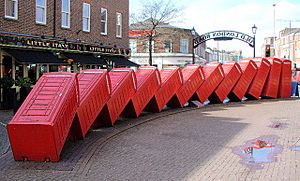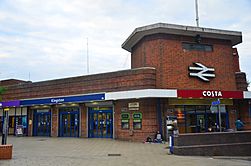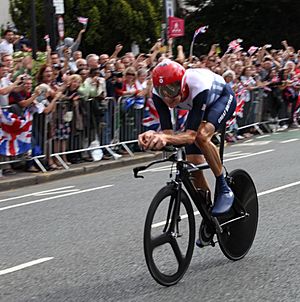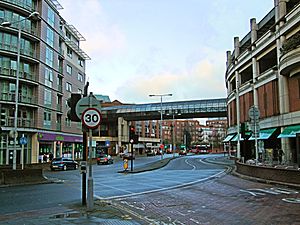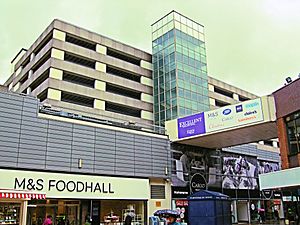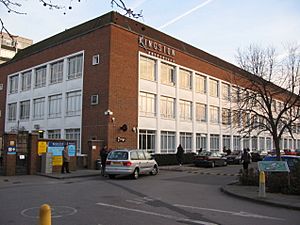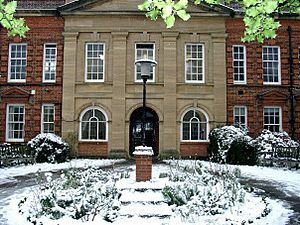Kingston upon Thames facts for kids
Quick facts for kids Kingston upon Thames |
|
|---|---|
| Population | 43,013 |
| OS grid reference | TQ182693 |
| • Charing Cross | 10.0 mi (16.1 km) NE |
| London borough | |
| Ceremonial county | Greater London |
| Region | |
| Country | England |
| Sovereign state | United Kingdom |
| Post town | KINGSTON UPON THAMES |
| Postcode district | KT1, KT2 |
| Dialling code | 020 |
| Police | Metropolitan |
| Fire | London |
| Ambulance | London |
| EU Parliament | London |
| UK Parliament |
|
| London Assembly |
|
Kingston upon Thames (hyphenated until 1965, colloquially known as Kingston) is a town in the Royal Borough of Kingston upon Thames, South West London, England. It is situated on the River Thames and 10 miles (16 km) southwest of Charing Cross. It is notable as the ancient market town in which Saxon kings were crowned and today is the administrative centre of the Royal Borough.
Historically in the county of Surrey, the ancient parish of Kingston became absorbed in the Municipal Borough of Kingston-upon-Thames, reformed in 1835. From 1893 to 2021 it was the location of Surrey County Council, extraterritorially in terms of local government administration since 1965, when Kingston became a part of Greater London.
Today, most of the town centre is part of the KT1 postcode area, but some areas north of Kingston railway station are within KT2. The United Kingdom Census 2011 recorded the population of the town (comprising the four wards of Canbury, Grove, Norbiton and Tudor) as 43,013, while the borough overall counted 175,470. Kingston is identified as a metropolitan centre in the London Plan and is one of the biggest retail centres in the UK, receiving 18 million visitors a year. It is also home to Kingston University.
Contents
History
Early history

Kingston was called Cyninges tun in 838, Chingestune in 1086, Kingeston in 1164, Kyngeston super Tamisiam in 1321 and Kingestowne upon Thames in 1589. The name means 'the king's manor or estate' from the Old English words cyning and tun. It belonged to the king in Saxon times and was the earliest royal borough. It was first mentioned in 838 as the site of a meeting between King Egbert of Wessex and Ceolnoth, Archbishop of Canterbury. Kingston lay on the boundary between the ancient kingdoms of Wessex and Mercia, until in the early tenth century when King Athelstan united both to create the kingdom of England. Probably because of the town's symbolic location, several tenth-century kings were crowned in Kingston, Æthelstan in 925, Eadred in 946 and Æthelred in 978. Other kings who may have been crowned there are Edward the Elder in 902, Edmund in 939, Eadwig in 956, Edgar in about 960 and Edward the Martyr in 975. It was later thought that the coronations took place in the chapel of St Mary, which collapsed in 1730, and a large stone recovered from the ruins has been regarded since the eighteenth century as the Coronation Stone. It was initially used as a mounting block, but in 1850 it was moved to a more dignified place in the market before finally being moved to its current location in the grounds of the guildhall.
Economic development
For much of the 20th century, Kingston was a major military aircraft manufacturing centre specialising in fighter aircraft – first with Sopwith Aviation, H G Hawker Engineering, later Hawker Aircraft, Hawker Siddeley and eventually British Aerospace. The renowned Sopwith Camel, Hawker Fury, Hurricane, Hunter and Harrier were all designed and built in the town and examples of all of these aircraft can be seen today at the nearby Brooklands Museum in Weybridge. Well known aviation personalities Sydney Camm, Harry Hawker and Tommy Sopwith were responsible for much of Kingston's achievements in aviation. British Aerospace finally closed its Lower Ham Road factory in 1992; part of the site was subsequently redeveloped for housing but the riverside part houses a community centre and sports complex. The growth and development of Kingston Polytechnic and its transformation into Kingston University has made Kingston a university town.
Local government
Kingston upon Thames formed an ancient parish in the Kingston hundred of Surrey. The parish of Kingston upon Thames covered a large area including Hook, Kew, New Malden, Petersham, Richmond, Surbiton, Thames Ditton and East Molesey.
The town of Kingston was granted a charter by King John in 1200, but the oldest one to survive is from 1208 and this document is housed in the town's archives. Other charters were issued by later kings, including Edward IV's charter that gave the town the status of a borough in 1481. The borough covered a much smaller area than the ancient parish, although as new parishes were split off the borough and parish eventually became identical in 1894. The borough was reformed by the Municipal Corporations Act 1835, becoming the Municipal Borough of Kingston-upon-Thames (then spelt with hyphens). It had been known as a Royal borough through custom and the right to the title was confirmed by George V in 1927. Kingston upon Thames has been the location of Surrey County Council since it moved from Newington in 1893.
In 1965 the local government of Greater London was reorganised and the municipal borough was abolished. Its former area was merged with that of the Municipal Borough of Surbiton and the Municipal Borough of Malden and Coombe, to form the London Borough of Kingston upon Thames. At the request of Kingston upon Thames London Borough Council another Royal Charter was granted by Queen Elizabeth II entitling it to continue using the title "Royal Borough of Kingston upon Thames" for the new borough.
Urban development
Kingston was built at the first crossing point of the Thames upstream from London Bridge and a bridge still exists at the same site. It was this 'great bridge' that gave it its early importance in the 13th century. Kingston was occupied by the Romans, and later it was either a royal residence or a royal demesne. There is a record of a council held there in 838, at which Egbert of Wessex, King of Wessex, and his son Ethelwulf of Wessex were present. In the Domesday Book it was held by William the Conqueror. Its domesday assets were: a church, five mills, four fisheries worth 10s, 27 ploughs, 40 acres (160,000 m2) of meadow, woodland worth six hogs. It rendered £31 10s (£31.5).
In 1730 the chapel containing the royal effigies collapsed, burying the sexton, who was digging a grave, the sexton's daughter and another person. The daughter survived this accident and was her father's successor as sexton. Kingston sent members to early Parliaments, until a petition by the inhabitants prayed to be relieved from the burden. Another chapel, the collegiate chapel of St Mary Magdalene, The Lovekyn Chapel, still exists. It was founded in 1309 by a former mayor of London, Edward Lovekyn. It is the only private chantry chapel to survive the Reformation.
With the coming of the railway in the 1830s, there was a great deal of development to the south of the town. Much of this became the new town of Surbiton, but the Surbiton Park estate, built in the grounds of Surbiton Place in the 1850s, remained part of Kingston during the period of the Municipal Borough of Kingston-upon-Thames.
A permanent military presence was established in the borough with the completion of The Barracks in 1875.
Notable locations
Central Kingston is a busy, largely pedestrian and predominantly retail centre, with a small number of commercial offices and civic buildings.
The shopping centre includes a shopping mall, "The Bentall Centre", containing the Bentalls department store and large branches of chain stores found in many British high streets. There is a large branch of the John Lewis department store group, with a Waitrose supermarket in the basement. A smaller 1960s shopping centre called Eden Walk exists nearby. The Rotunda, in a former Bentalls furniture depository building (a local landmark), includes a bowling alley, fitness centre, a 15-screen Odeon multiplex cinema and a few restaurants.
The ancient market is still held daily in the Market Place, including such produce as fish, jewellery, exotic foods, local foods and flowers.
Kingston's civic buildings include Kingston Museum, public library, modern Crown Court, smaller county court and the Guildhall. The Guildhall is located by the part-culverted mouth of the Hogsmill River, and houses Kingston Council and magistrates' court. A short distance away is the County Hall Building which houses the main offices of Surrey County Council. From 1893 to 1965, before Kingston became one of the 32 London boroughs of Greater London, it was the county town of Surrey following the period of 1791–1893 when Newington had this role. Guildford has officially reclaimed this ancient, now ceremonial title as Kingston is no longer administered by Surrey.
Kingston's main open space is the River Thames, with its lively frontage of bars and restaurants. Downstream there is a walk through Canbury Gardens towards Teddington Lock. Upstream there is a promenade crossing the Hogsmill river and reaching almost to Surbiton. Eagle Brewery Wharf is a council-owned public space located on the riverside. Across Kingston Bridge is a tree lined river bank fronting the expanse of Hampton Court Park.
Culture
A notable dramatic arts venue is the Rose Theatre. This theatre opened on 16 January 2008 and seats approximately 899 people. The audience are arranged around the semi-circular stage. All Saints Church is host to classical choral and music concerts mostly on Saturdays and houses a Frobenius organ. There are a number of choral societies including the Kingston Orpheus Choir and the Kingston Choral Society, an amateur symphony orchestra the Kingston Philharmonia, and the Kingston and District Chamber Music Society. A number of annual festivals are organised by the Council and Kingston Arts Council including Kingston Readers' Festival, Think-in-Kingston and the Festival of the Voice. Kingston University runs the Stanley Picker Gallery and Kingston Museum has a changing gallery on the first floor. A regular singing group at the Rose Theatre caters to schools and families.
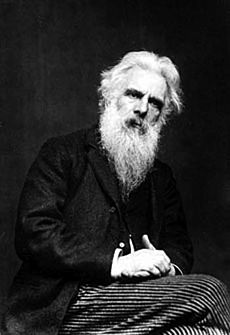
John Galsworthy the author was born on Kingston Hill and Jacqueline Wilson grew up, and went to school in Kingston and still lives there today. Both are commemorated at Kingston University – Galsworthy in the newest building and Wilson in the main hall. Also commemorated at the University is photographer Eadweard Muybridge who was born at Kingston and changed the spelling of his first name in reference to the name of the Saxon king on the Coronation Stone. He was a pioneer in the photography of the moving image. R. C. Sheriff the playwright is also associated with Kingston, writing his first play to support Kingston Rowing Club. An earlier writer born in Kingston was John Cleland.
Kingston has been covered in literature, film and television. It is where the comic Victorian novel Three Men in a Boat by Jerome K. Jerome begins; cannons aimed against the Martians in H. G. Wells' The War of the Worlds are positioned on Kingston Hill; in The Rainbow by D. H. Lawrence the youngest Brangwen dreams of a job in Kingston upon Thames in a long, lyrical passage; Mr. Knightly in Emma by Jane Austen regularly visits Kingston, although the narrative never follows him there.
Early in his music career, the guitarist and singer-songwriter Eric Clapton spent time busking in Kingston upon Thames, having grown up and studied in the area.
Kingston is mentioned (and used as a filming location) in episodes of Monty Python's Flying Circus. More recently, a scene from Mujhse Dosti Karoge, a Bollywood film starring Hrithik Roshan as the leading actor, was filmed by the toppled telephone boxes sculpture in Old London Road. A scene in the television programme The Good Life sees Richard Briers get on a 71 bus in 'The Avenue' towards Kingston town centre (albeit this route never served the east side of Surbiton where the series is set). The 1974 Doctor Who story "Invasion of the Dinosaurs" used several locations in the town for filming. The 2008 series of Primeval, shown on ITV1 in January, featured almost an entire episode filmed inside the Bentall Centre and John Lewis department stores. Kingston featured in Primeval again in May 2009 with several scenes shot in and around the Market Place. Nipper, the famous "His Master's Voice" (HMV) dog, is buried in the town under Lloyds Bank. His owners lived nearby in Fife Road.
Kingston Green Fair was held annually from 1987 to 2008 in Canbury Gardens, next to the river, on the Spring Bank Holiday. The word "Green" in the title refers to the ethos of the fair as promoting sustainable development. For instance no meat or other products derived from dead animals were allowed to be sold, and no electricity was permitted on the site unless generated by wind, sun, or bicycle power. Kingston is also home to Crack Comedy Club which opened at The Grey Horse Pub in 2002.
Landmarks
One of the more unusual sights in Kingston is Out of Order by David Mach, a sculpture in the form of twelve disused red telephone boxes that have been tipped up to lean against one another in an arrangement resembling dominoes. The work was commissioned in 1988 as part of the landscaping for the new Relief Road, and was described by its creator as "anti-minimalist".
Transport
Rail
Kingston is principally served by Kingston railway station, which opened in 1863.
The station is in London fare zone 6 and is served by South Western Railway trains from London Waterloo. Trains to Waterloo link Kingston directly to destinations such as Wimbledon, Clapham Junction and Vauxhall. Eastbound trains travel to Shepperton via Teddington, Hampton and Sunbury. Eastbound trains also travel on the Kingston loop line towards Teddington, Strawberry Hill, Twickenham and Richmond, after which trains continue towards Waterloo. From Waterloo, trains to Kingston are advertised towards "Shepperton" and "Strawberry Hill".
A nearby station in Norbiton (in fare zone 5) is on the same lines.
Nearby Surbiton station - originally named Kingston when it opened in 1838 - is on the South West Main Line in London fare zone 6. Surbiton is also served by South Western Railway trains from Waterloo. Southbound services link Surbiton to destinations in Surrey and Hampshire, such as Hampton Court, Guildford, Woking and Basingstoke. The station building at Surbiton was built in 1937, designed in Art Deco style by James Robb Scott. It is Grade II listed.
Bus
Kingston is served by two bus stations, Cromwell Road and Fairfield, and a large number of bus stops, with destinations across Greater London and Surrey including links directly to Heathrow Airport.
Road
The Kingston Bypass passes to the south and east of Kingston. The bypass carries the A3, which links the area to Wandsworth, Clapham and the City of London to the north. To the south, the A3 runs to Portsmouth via Guildford and Petersfield.
A portion of the bypass carries the A309 to Thames Ditton, Hampton Court and the A308.
There are several radial routes including:
- A238 towards Raynes Park, Colliers Wood and Tooting
- A240 towards Banstead and Epsom
- A2043 towards New Malden and Cheam
- A307 northbound towards Petersfield, Richmond and the M4, or southbound towards Thames Ditton, Esher and Cobham
- A308 eastbound towards the A3, Putney and Wandsworth and westbound towards Hampton Court, Sunbury-on-Thames (for M3) and Staines
- A310 via A308 northbound towards Teddington and Twickenham
Kingston Relief Road
In the 1960s, planners proposed a partially elevated ring road encircling the town centre, to alleviate congestion on major shopping streets and traffic heading towards Kingston Bridge. After objections from local residents, an interim one-way system was implemented in July 1963. Following this, the Kingston Relief Road was constructed in Kingston town centre in the late 1980s. Commonly known as the "Kingston one-way system", the road encircles the town centre, allowing for major shopping streets such as Clarence Street to be pedestrianised. On the eastern side of the town centre, the road passes underneath John Lewis Kingston in a tunnel, before crossing the River Thames via Kingston Bridge. As part of the project, two bus stations were constructed, cycle lanes installed and several artworks commissioned including Out of Order by David Mach and River Celebration by Carole Hodgson.
River
Kingston Town End and Kingston Turks piers are situated in Kingston. Turk Launches operates a Summer-only river tour between Hampton Court and Richmond St Helena.
Cycling
There is a network of cycle lanes throughout Kingston linking the area to destinations throughout south-west London and England.
Key routes include:
- National Cycle Route 4 - A route from Greenwich in south-east London to St David's in west Wales. NCR4 follows the route of the River Thames near Kingston, crossing from the south side of the river to the north over Kingston Bridge. Northbound, the route runs towards Central London and Greenwich via Ham, Richmond Park and Barnes. Westbound, NCR4 runs towards Reading via Walton, Egham and Eton. The route is part of EuroVelo 2, a route from Moscow to Galway.
- Cycleway 28 - A two-way, segregated cycle track between Kingston and Seething Wells along Portsmouth Road.
- Cycleway 29 - A cycle route, much of which is two-way and segregated from other road traffic between Kingston and Fishponds Park. Much of the route follows Penrhyn Road and Ewell Road.
- Cycleway 30 - A segregated cycle track between C29 at Kingston to Putney Vale, following the route of A308 London Road.
Religious sites
The 12th century church of All Saints serves the Church of England parish of Kingston which lies ecclesiastically in the Diocese of Southwark, although there has been a church in Kingston since at least 838. The suffragan or Area Bishop of Kingston is the Rt Rev. Dr Richard Cheetham. Other Anglican churches in Kingston, of more recent date, are St John the Evangelist and St Luke. Kingston lies in the Roman Catholic Archdiocese of Southwark, and there is a Roman Catholic church dedicated to Saint Agatha. Kingston is also the home of the Kingston Surbiton & District Synagogue. Kingston also has a Quaker meeting house, a Mosque and a Sikh Gurdwara.
London 2012 Summer Olympics
The borough was the setting for four cycling events during the 2012 Summer Olympics, the men's road race, women's road race, men's road time trial and women's road time trial. Prior to the opening of the games, Kingston hosted the 2012 Summer Olympics torch relay on two occasions with the flame travelling through the borough on 24 July 2012 and aboard the Gloriana in a cauldron on 27 July 2012 en route to the Olympic Stadium for the opening ceremony.
Nearest places
 |
Teddington, Twickenham | Ham | Kingston Vale across Richmond Park: Roehampton |
 |
| Hampton Wick and Hampton Court across Bushy Park: Hampton across Hampton Court Park: East Molesey |
Coombe and New Malden | |||
| Surbiton then Thames Ditton |
Surbiton then Hook, Chessington |
Berrylands and Tolworth |
Town twinning
Kingston upon Thames has been twinned with Oldenburg in Germany since 2010. It also has been historically twinned with the town Delft in the Netherlands. In 2016, Kingston upon Thames has been twinned with Jaffna in Sri Lanka.
Economy
Kingston has many pubs and restaurants and several public houses in the centre have become restaurants or bars. The more traditional pubs tend to be in the northern part of the town (Canbury) and include The Canbury Arms, Park Tavern, The Wych Elm and Willoughby Arms. Further south are found the Druid's Head, the Spring Grove, The Cricketers, The Albion Tavern, The Duke of Buckingham, and several small local pubs around Fairfield. The Druid's Head is notable as one of the first taverns to make the famous dessert syllabub in the 18th century. There are several Chinese, Indian, Thai and Italian restaurants.
The local newspapers are the weekly Surrey Comet, which celebrated its 150th year in 2004, and the Kingston Guardian.
In 2010 retail footprint research, Kingston ranked 25th in terms of retail expenditure in the UK at £810 million, equal to Covent Garden and just ahead of Southampton. This puts it as generating the fifth most amount of money from the retail sector in Greater London, passing Croydon, with just four West End alternatives ahead. In 2005, Kingston was 24th with £864 million, and 3rd in London. In a 2015 study by CACI, Kingston was ranked 28th in the UK in the Hot 100 Retail Locations - and the second highest in Greater London after Croydon. In 2018, Kingston was ranked joint 5th in the UK by Knight Frank in the "High Street Investment Ranking", only bettered by Cambridge, Bath, Chichester and Reading.
As of 2011, Kingston upon Thames has the fourth highest retail turnover for comparison goods in Greater London, £432 million annually, only bettered by the West End, Shepherd's Bush and Stratford. As of 2012, Kingston has 276,438 square metres (2,975,550 sq ft) of total town centre floorspace, the 3rd highest in London.
Sport
Kingston is the home of four association football clubs, AFC Wimbledon who play at the Kingsmeadow Stadium, Corinthian-Casuals and Kingstonian who play in Tolworth and Chessington & Hook United who play in Chessington. AFC Wimbledon have played in League One since the 2016–17 season, whereas Kingstonian, Corinthian-Casuals and Chessington & Hook United are non-league clubs.
Kingston Athletic Club and Polytechnic Harriers are based at the neighbouring Kingsmeadow athletics stadium. This stadium boasts a 400m track which is floodlit, a gym and 5-a-side football facilities. In the 2013 season the men competed in Division 3 of the British Athletics League. Kingston Rugby Club is based on the outskirts of the town, and Kingston Rowing Club (founded in 1858) is based in Canbury Gardens on the River Thames. The Club holds two large timed race events (HEADs) in the Spring and Autumn. Kingston Regatta takes place on the river just above the bridge over a weekend in early July.
The town has a large leisure centre next to Fairfield named the Kingfisher Centre, which contains an indoor swimming pool and gymnasium. Sport in Kingston is promoted and encouraged by Sport Kingston, an organisation funded by the Royal Borough of Kingston.
Kingston Wildcats School of Basketball is a community basketball development club that practices and plays its home fixtures at Chessington School, competing in the Surrey League and Basketball England National League.
London 2012 Summer Olympics
Prior to the opening of the games, Kingston hosted the 2012 Summer Olympics torch relay on two occasions with the flame travelling through the borough on 24 July 2012 and aboard the Gloriana in a cauldron on 27 July 2012 en route to the Olympic Stadium for the opening ceremony. The borough was the setting for four cycling events during the Olympics, the men's road race, women's road race, men's road time trial and women's road time trial.
Following the games, the London–Surrey Classic professional road bicycle race ran through the town from 2013-18, using a similar course to the Olympic road race. Following the COVID-19 pandemic, the race will not return to Kingston, with the RideLondon festival using the roads of Essex instead.
Education
Kingston is the location of Kingston University and Kingston College. Primary schools in the town include Latchmere School, Fernhill School, King Athelstan School and St Agatha's Catholic Primary School. Secondary schools in the town include The Kingston Academy, Holy Cross School and Richard Challoner School. Kingston also is home to Tiffin School, Tiffin Girls' School and Kingston Grammar School, all of which have large catchment areas across Greater London and Surrey.


